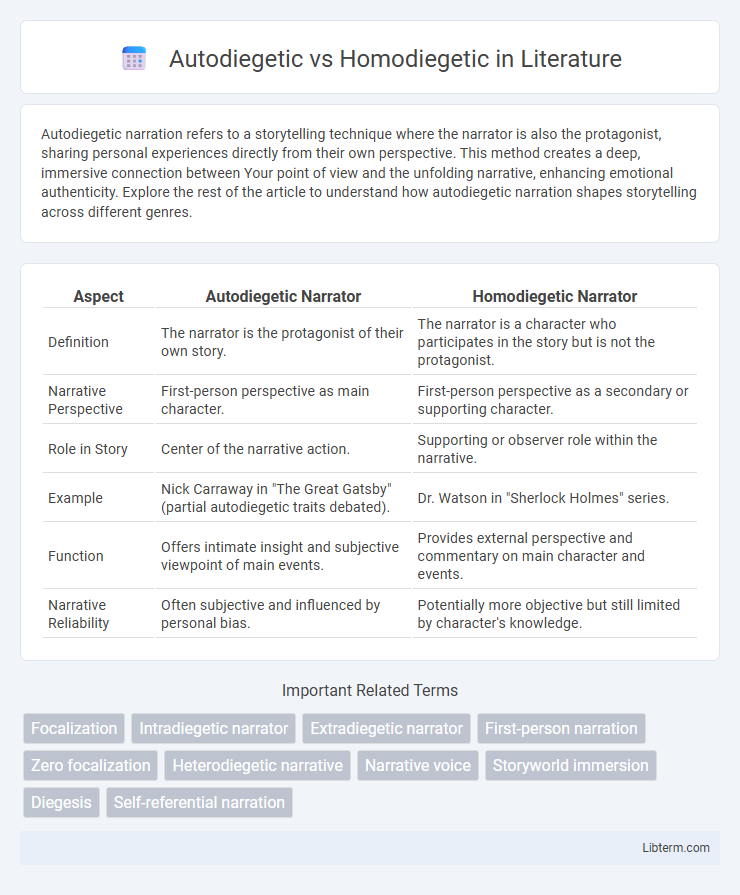Autodiegetic narration refers to a storytelling technique where the narrator is also the protagonist, sharing personal experiences directly from their own perspective. This method creates a deep, immersive connection between Your point of view and the unfolding narrative, enhancing emotional authenticity. Explore the rest of the article to understand how autodiegetic narration shapes storytelling across different genres.
Table of Comparison
| Aspect | Autodiegetic Narrator | Homodiegetic Narrator |
|---|---|---|
| Definition | The narrator is the protagonist of their own story. | The narrator is a character who participates in the story but is not the protagonist. |
| Narrative Perspective | First-person perspective as main character. | First-person perspective as a secondary or supporting character. |
| Role in Story | Center of the narrative action. | Supporting or observer role within the narrative. |
| Example | Nick Carraway in "The Great Gatsby" (partial autodiegetic traits debated). | Dr. Watson in "Sherlock Holmes" series. |
| Function | Offers intimate insight and subjective viewpoint of main events. | Provides external perspective and commentary on main character and events. |
| Narrative Reliability | Often subjective and influenced by personal bias. | Potentially more objective but still limited by character's knowledge. |
Introduction to Narrative Perspectives
Autodiegetic narration occurs when the storyteller is also the main character, providing a first-person perspective that blends personal experience with narrative reflection. Homodiegetic narration features a narrator who participates in the story but is not necessarily the central figure, allowing for a subjective yet sometimes more observational viewpoint. These narrative perspectives shape readers' engagement by influencing the reliability and intimacy of the story's voice.
Defining Autodiegetic Narration
Autodiegetic narration occurs when the narrator is the protagonist of the story, narrating events from their own perspective and experience. This type of narration allows for deep psychological insight and intimate access to the narrator's thoughts and emotions. It differs from homodiegetic narration, where the narrator is part of the story but not necessarily the central character.
Understanding Homodiegetic Narration
Homodiegetic narration occurs when the narrator is also a character within the story they are telling, providing a personal perspective on the events and inner thoughts. This narrative style enables deep emotional engagement and subjective insight, as the narrator's experiences and biases shape the storytelling. Understanding homodiegetic narration is essential for analyzing how character-driven viewpoints influence plot development and reader interpretation.
Key Differences between Autodiegetic and Homodiegetic
Autodiegetic narrators are characters who tell their own story, providing a first-person perspective and direct insight into their thoughts and experiences, while homodiegetic narrators are characters within the story but may narrate events involving other characters as well. The key difference lies in narrative perspective: autodiegetic narration is strictly self-focused, whereas homodiegetic narration can encompass a broader viewpoint within the story world. This distinction influences the scope of storytelling, with autodiegetic narrators offering a subjective, intimate account and homodiegetic narrators delivering a more rounded but still character-bound narration.
The Role of the Narrator in Each Perspective
Autodiegetic narrators are characters who both experience and recount the story, offering a deeply personal and subjective viewpoint that blurs the line between narrator and protagonist. Homodiegetic narrators are characters within the story but do not always serve as the main protagonist, providing insights limited to their own perspective while still participating in the narrative. The role of the narrator in autodiegetic narration emphasizes self-reflection and internal conflict, whereas homodiegetic narration highlights interaction with other characters and events from a participant's viewpoint.
Examples of Autodiegetic Narrators in Literature
Autodiegetic narrators are characters who tell their own story from a first-person perspective, exemplified by Holden Caulfield in J.D. Salinger's *The Catcher in the Rye* and Nick Carraway in F. Scott Fitzgerald's *The Great Gatsby*. These narrators provide a subjective account of events they personally experience, blending personal insight with narrative bias. The autodiegetic perspective enhances reader engagement by offering intimate access to the narrator's thoughts and emotions.
Examples of Homodiegetic Narrators in Literature
Homodiegetic narrators appear as characters within the story they tell, providing a subjective viewpoint that enhances reader engagement and character development. Examples include Nick Carraway in F. Scott Fitzgerald's *The Great Gatsby*, who offers an insightful perspective on Jay Gatsby and the social milieu of the 1920s. Another prominent homodiegetic narrator is Holden Caulfield in J.D. Salinger's *The Catcher in the Rye*, whose first-person narrative reveals his inner conflicts and distinctive voice.
Narrative Reliability and Subjectivity
Autodiegetic narrators, who tell their own stories, often exhibit heightened subjectivity that directly influences narrative reliability, as their personal biases and selective memory shape the account. Homodiegetic narrators, participating in the narrative but not the protagonist, provide a perspective that can either align with or challenge the protagonist's viewpoint, affecting the trustworthiness of the narrative. Understanding these narrative roles is crucial for analyzing the degree of reliability and interpretive subjectivity embedded within a text.
Impact on Storytelling and Reader Engagement
Autodiegetic narrators, as protagonists recounting their own experiences, create intimate connections that enhance reader empathy and deepen emotional investment in the story. Homodiegetic narrators, who participate as characters but are not the main focus, provide subjective viewpoints that shape narrative reliability and perspective, influencing how readers interpret events and bias. The choice between autodiegetic and homodiegetic narration significantly affects storytelling dynamics by controlling narrative depth, reader trust, and engagement intensity.
Choosing the Right Narrative Voice for Your Story
Selecting the right narrative voice involves understanding the difference between autodiegetic and homodiegetic narrators; an autodiegetic narrator tells their own story from a first-person perspective, helping readers connect deeply with the protagonist's inner world. A homodiegetic narrator, who also participates in the story but may not be the main character, offers a more nuanced perspective that can reveal multiple facets of the narrative's events. Choosing between these voices depends on whether the story benefits from intimate self-reflection or a broader participant viewpoint to enhance storytelling impact.
Autodiegetic Infographic

 libterm.com
libterm.com